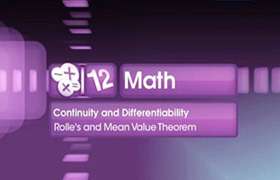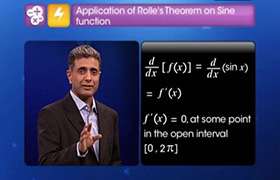CBSE Class 12-science Answered
Verify Rolle’s theorem for the function f (x) = x2 – 5x + 6 on the interval [2, 3].
Asked by Topperlearning User | 04 Jun, 2014, 01:23: PM
Since a polynomial function is everywhere differentiable and so continuous also. Therefore,
(i) f (x) is continuous on [2, 3]
and (ii) f (x) is differentiable on (2, 3)
Also, f (2) = 22 – 5 × 2 + 6 = 0 and f (3) = 32 – 5 × 3 + 6 = 0
\ f (2) = f (3)
Thus all the conditions of Rolle’s theorem are satisfied. Now we have to show that there exists some c Î (2, 3) such that f ¢ (c) = 0
For this we proceed as follows :
We have,
f (x) = x2 – 5x + 6 Þ f ¢ (x) = 2x – 5
\ f ¢ (x) = 2x – 5 = 0 Þ x = 2.5
Thus, c = 2.5 Î (2, 3) such that f ¢ (c) = 0
Hence, Rolle’s theorem is verified.
Answered by | 04 Jun, 2014, 03:23: PM
Concept Videos
CBSE 12-science - Maths
Asked by Topperlearning User | 04 Aug, 2014, 03:57: PM
CBSE 12-science - Maths
Asked by Topperlearning User | 04 Aug, 2014, 04:00: PM
CBSE 12-science - Maths
Asked by Topperlearning User | 04 Aug, 2014, 04:03: PM
CBSE 12-science - Maths
Asked by Topperlearning User | 04 Aug, 2014, 04:11: PM
CBSE 12-science - Maths
Asked by Topperlearning User | 04 Jun, 2014, 01:23: PM
CBSE 12-science - Maths
Asked by Topperlearning User | 05 Aug, 2014, 08:38: AM
CBSE 12-science - Maths
Asked by Topperlearning User | 04 Aug, 2014, 03:32: PM
CBSE 12-science - Maths
Asked by Topperlearning User | 04 Aug, 2014, 03:48: PM
CBSE 12-science - Maths
Asked by Topperlearning User | 04 Aug, 2014, 04:16: PM
CBSE 12-science - Maths
Asked by Topperlearning User | 04 Aug, 2014, 04:35: PM





 on [– 2, 2].
on [– 2, 2]. on [a, b], where 0 < a < b.
on [a, b], where 0 < a < b.
